-
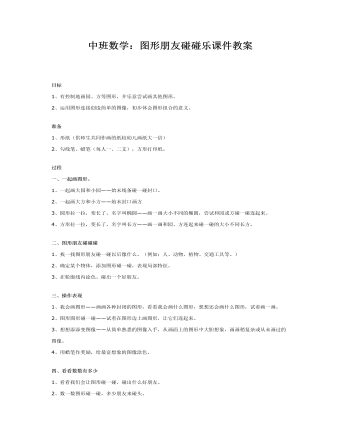
中班数学:图形朋友碰碰乐课件教案
2、运用图形连接创造简单的图像,初步体会图形组合的意义。准备1、形纸(供师生共同作画的纸较幼儿画纸大一倍)2、勾线笔、蜡笔(每人一、二支),方形打印纸。过程一、一起画图形。1、一起画大园和小园——始末线条碰一碰封口。2、一起画大方和小方——始末封口画方3、圆形拉一拉,变长了,名字叫椭圆——画一画大小不同的椭圆,尝试和园或方碰一碰连起来。4、方形拉一拉,变长了,名字叫长方——画一画和园、方连起来碰一碰的大小不同长方。二、图形朋友碰碰碰1、找一找图形朋友碰一碰以后像什么。(例如:人、动物、植物、交通工具等。)2、确定某个物体,添加图形碰一碰,表现局部特征。3、在轮廓线内涂色。碰出一个好朋友。
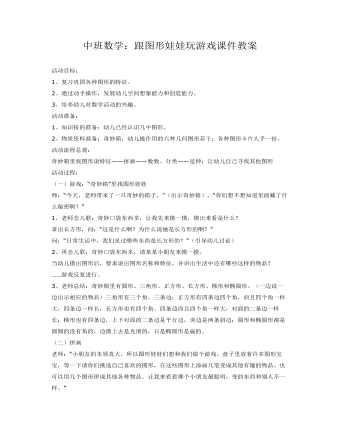
中班数学:跟图形娃娃玩游戏课件教案
2、通过动手操作,发展幼儿空间想象能力和创造能力。3、培养幼儿对数学活动的兴趣。活动准备:1、知识按的准备:幼儿已经认识几中图形。2、物质资料准备:奇妙箱,幼儿操作用的六种几何图形若干;各种图形卡片人手一份。活动流程总观:奇妙箱里找图形说特征——拼画——数数、分类——延伸:让幼儿自己寻找其他图形活动过程:(一)游戏:“奇妙箱”里找图形娃娃师:“今天,老师带来了一只奇妙的箱子。”(出示奇妙箱),“你们想不想知道里面藏了什么秘密啊?”1、老师念儿歌:奇妙口袋东西多,让我先来摸一摸,摸出来看是什么?拿出长方形,问:“这是什么啊?为什么说她是长方形的啊?”问:“日常生活中,我们见过哪些东西是长方形的?”(引导幼儿讨论)2、再念儿歌:奇妙口袋东西多,请某某小朋友来摸一摸。当幼儿摸出图形后,要求说出图形名称和特征,并讲出生活中还有哪些这样的物品?……游戏反复进行。
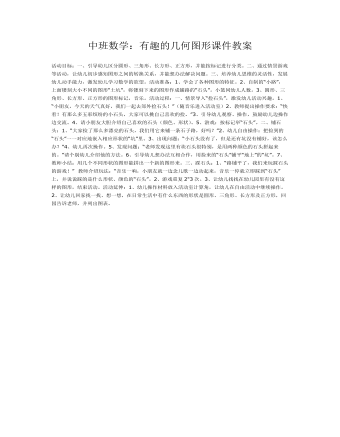
中班数学:有趣的几何图形课件教案
二、通过情景游戏等活动,让幼儿初步感知图形之间的转换关系,并能想办法解决问题。三、培养幼儿思维的灵活性,发展幼儿动手能力,激发幼儿学习数学的欲望。活动准备:1、学会了各种图形的特征。2、自制的“小路”,上面镂刻大小不同的图形“土坑”,将镂刻下来的图形作成铺路的“石头”。小篮同幼儿人数。3、圆形、三角形、长方形、正方形的图形标记,音乐。活动过程:一、情景导入“捡石头”,激发幼儿活动兴趣。1、“小朋友,今天的天气真好,我们一起去郊外捡石头!”(随音乐进入活动室)2、教师提出操作要求:“快看!有那么多五彩缤纷的小石头,大家可以挑自己喜欢的捡。”3、引导幼儿观察、操作,鼓励幼儿边操作边交流。4、请小朋友大胆介绍自己喜欢的石头(颜色、形状)。5、游戏:按标记举“石头”。
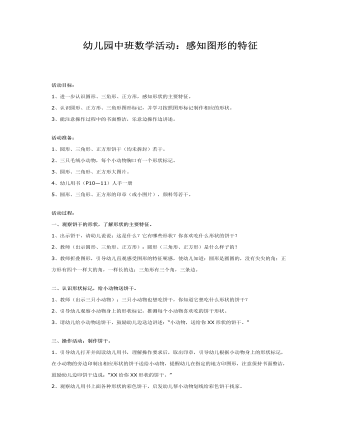
中班数学活动:感知图形的特征课件教案
2、认识圆形、正方形、三角形图形标记,并学习按照图形标记制作相应的形状。 3、能注意操作过程中的书面整洁,乐意边操作边讲述。 活动准备: 1、圆形、三角形、正方形饼干(均未拆封)若干。 2、三只毛绒小动物,每个小动物胸口有一个形状标记。 3、圆形、三角形、正方形大图片。 4、幼儿用书(P10—11)人手一册 5、圆形、三角形、正方形的印章(或小图片),颜料等若干。 活动过程: 一、观察饼干的形状,了解形状的主要特征。1、出示饼干,请幼儿说说:这是什么?它有哪些形状?你喜欢吃什么形状的饼干? 2、教师(出示圆形、三角形、正方形):圆形(三角形、正方形)是什么样子的? 3、教师折叠图形,引导幼儿直观感受图形的特征呢感,使幼儿知道:圆形是圆圆的,没有尖尖的角;正方形有四个一样大的角,一样长的边;三角形有三个角,三条边。
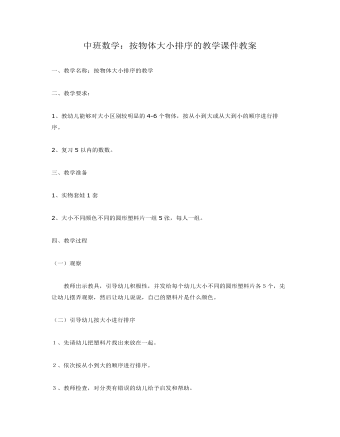
中班数学:按物体大小排序的教学课件教案
二、教学要求:1、教幼儿能够对大小区别较明显的4-6个物体,按从小到大或从大到小的顺序进行排序。2、复习5以内的数数。三、教学准备1、实物套娃1套2、大小不同颜色不同的圆形塑料片一组5张,每人一组。

中班传统文化社会教案幼儿园传统文化教案
1、对春联产生兴趣,乐于交流自己的发现。 2、大胆探索并发现春联的特征和种类,体验张贴春联的的乐趣。 3、初步了解春联的演变。 【活动准备】 物质准备: 1、春节里幼儿与家长一起贴春联的照片。 2、红纸、毛笔、砚台等。 经验准备: 1、幼儿有贴春联的经验 2、了解春联的由来和传说。 3、联系会写春联的家长助教
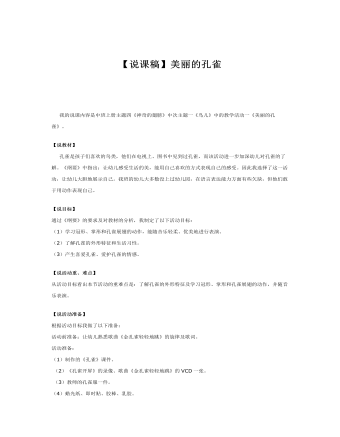
中班主题课件教案:美丽的孔雀(说课和教案)
【说教材】 孔雀是孩子们喜欢的鸟类,他们在电视上、图书中见到过孔雀,而该活动进一步加深幼儿对孔雀的了解。《纲要》中指出:让幼儿感受生活的美,能用自己喜欢的方式表现自己的感受。因此我选择了这一活动,让幼儿大胆地展示自己。我班的幼儿大多数没上过幼儿园,在语言表达能力方面有些欠缺,但他们敢于用动作表现自己。【说目标】通过《纲要》的要求及对教材的分析,我制定了以下活动目标:(1)学习冠形、掌形和孔雀展翅的动作,能随音乐轻柔、优美地进行表演。(2)了解孔雀的外形特征和生活习性。(3)产生喜爱孔雀、爱护孔雀的情感。【说活动重、难点】从活动目标看出本节活动的重难点是:了解孔雀的外形特征及学习冠形、掌形和孔雀展翅的动作,并随音乐表演。
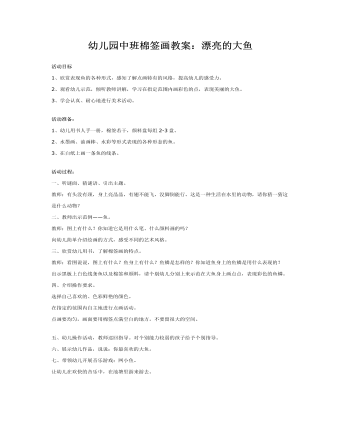
中班棉签画教案:漂亮的大鱼课件教案
2、观看幼儿示范,倾听教师讲解,学习在指定范围内画彩色的点,表现美丽的大鱼。 3、学会认真、耐心地进行美术活动。 活动准备: 1、幼儿用书人手一册,棉签若干,颜料盘每组2-3盘。 2、水墨画、油画棒、水彩等形式表现的各种形态的鱼。 3、在白纸上画一条鱼的线条。 活动过程:一、听谜面、猜谜语、引出主题。 教师:有头没有颈,身上亮晶晶,有翅不能飞,没脚倒能行。这是一种生活在水里的动物,请你猜一猜这是什么动物?
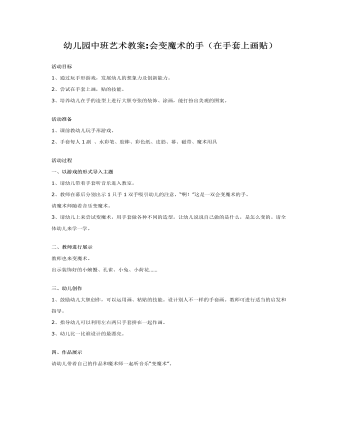
中班艺术教案:会变魔术的手课件教案
2、尝试在手套上画,贴的技能。 3、培养幼儿在手的造型上进行大胆夸张的装饰、涂画,能打扮出美观的图案。 活动准备 1、课前教幼儿玩手形游戏。 2、手套每人1副、水彩笔、胶棒、彩色纸、皮筋、幕、磁带、魔术用具活动过程一、以游戏的形式导入主题 1、请幼儿带着手套听音乐进入教室。 2、教师在幕后分别出示1只手1双手吸引幼儿的注意,“啊!”这是一双会变魔术的手。 请魔术师随着音乐变魔术。 3、请幼儿上来尝试变魔术,用手套做各种不同的造型。让幼儿说说自己做的是什么,是怎么变的。请全体幼儿来学一学。
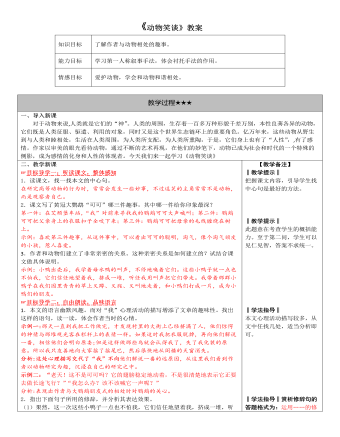
部编版语文七年级上册《动物笑谈》教案
1.读课文,找一找本文的中心句。在研究高等动物的行为时,常常会发生一些妙事,不过逗笑的主角常常不是动物,而是观察者自己。2.课文写了黄冠大鹦鹉“可可”哪三件趣事,其中哪一件给你印象最深?第一件:在艾顿堡车站,“我”对前来寻找我的鹦鹉可可大声喊叫;第二件:鹦鹉可可把父亲身上的衣服扣子全咬下来;第三件:鹦鹉可可把母亲的毛线缠绕在树上。示例:喜欢第三件趣事,从这件事中,可以看出可可的聪明,淘气,像个淘气顽皮的小孩,惹人喜爱。3.作者和动物们建立了非常亲密的关系。这种亲密关系是如何建立的?试结合课文做具体说明。示例:小鸭出壳后,我学着母水鸭的叫声,不停地唤着它们。这些小鸭子就一点也不怕我,它们信任地望着我,挤成一堆,听任我用叫声把它们带走。我带着那群小鸭子在我们园里青青的草上又蹲、又爬、又叫地走着,和小鸭们打成一片,成为小鸭们的朋友。
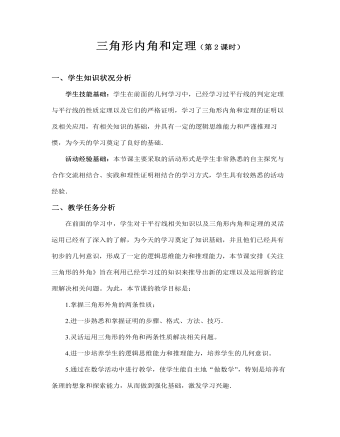
三角形内角和定理教案教学设计
活动内容:① 已知,如图,在三角形ABC中,AD平分外角∠EAC,∠B=∠C.求证:AD∥BC分析:要证明AD∥BC,只需证明“同位角相等”,即需证明∠DAE=∠B.证明:∵∠EAC=∠B+∠C(三角形的一个外角等于和它不相邻的两个内角的和)∠B=∠C(已知)∴∠B=∠EAC(等式的性质)∵AD平分∠EAC(已知)∴∠DAE=∠EAC(角平分线的定义)∴∠DAE=∠B(等量代换)∴AD∥BC(同位角相等,两直线平行)想一想,还有没有其他的证明方法呢?这个题还可以用“内错角相等,两直线平行”来证.

小学语文修辞手法教案专题课件
1、明喻: 明喻就是本体、喻体和比喻词都出现的比喻。例句:例如:长城像一条长龙。这个句子中,“长城”是本体,“像”是比喻词,“一条长龙”是喻体。2、暗喻: 暗喻又叫隐喻,只出现本体和喻体,不用比喻词语或用“是、变成、成为、等于”等喻词。例句:例如:山间的云雾构成了一幅精妙的山水画。这个句子中“山间的云雾”是本体,“构成”是比喻词,“一幅精妙的山水画”是喻体。3、借喻: 借喻是只出现用来代替本体的喻体,而本体和喻词都不出现。例句:落光了叶子的柳树上挂满了毛茸茸、亮晶晶的银条儿。这个句子中,本体、比喻词均没有出现,喻体是“银条儿”。

中班科学课件教案:奇妙的磁铁-水中取物
2、教学准备:磁铁;探索材料:回形针,玩具,一元硬币,夹子,茶叶罐等铁制材料和非铁制材料:积木,塑料玩具,纸杯,玻璃球,气球……装水的大盆两个;取物工具---篓子、盘子、有磁铁的钓钩、勺子、筷子等;空箱子2只,空盆1个3、教学过程a) 情景引入(出示大盆)师:陈老师遇到一个问题---小弟弟把许多东西一起扔到了这两个玩水的大盆里,这可怎么办呢? 提出问题讨论:怎样才能将这些东西拿出来呢?你们能帮我想想办法吗?

大班数学游戏教案:城堡夺旗(8的分合法)
准备:数字卡 棋盘 不同颜色的棋子 旋转六面体 各色旗 扑克牌 玩法:每组5名幼儿,一幅棋盘,每位幼儿一套1——7的扑克牌,每名幼儿持一粒不同颜色的棋子,将各自的棋子放在起点,按照自己的标志次序轮流掷旋转六面体,掷出数字几,就向前走几步,如果走到没有图案的格内,就让下一位幼儿掷旋转六面体;如果走到有图案的格子内,就大声说出图案的数量,并向其他幼儿提问该数字和哪一个数字合起来是8,然后与同伴一起从自己的数字卡中拿出相应的数字卡,拿对的幼儿向前走一步,拿错的幼儿原地不动,看谁先走到终点,谁就在城堡的最底层插一面与自己棋子颜色相同的彩旗。游戏反复进行,谁的彩旗第一个到达城堡的顶端,谁就取得胜利。
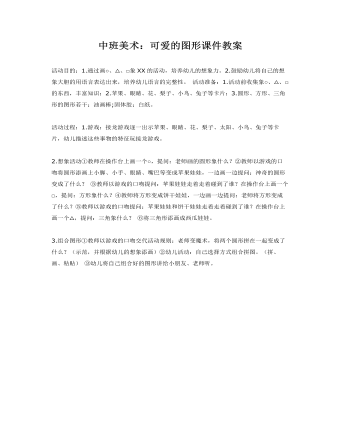
中班美术:可爱的图形课件教案
2.鼓励幼儿将自己的想象大胆的用语言表达出来,培养幼儿语言的完整性。活动准备:1.活动前收集象○、△、□的东西,丰富知识;2.苹果、眼睛、花、梨子、小鸟、兔子等卡片;3.圆形、方形、三角形的图形若干;油画棒;固体胶;白纸。活动过程:1.游戏:接龙游戏逐一出示苹果、眼睛、花、梨子、太阳、小鸟、兔子等卡片,幼儿描述这些事物的特征玩接龙游戏。
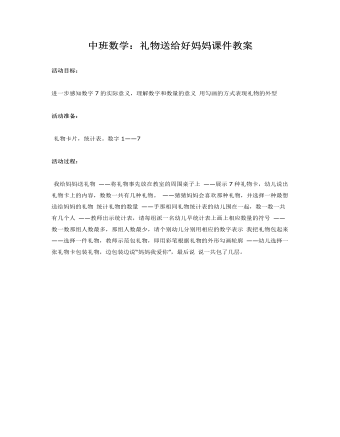
中班数学:礼物送给好妈妈课件教案
活动准备: 礼物卡片,统计表。数字1——7 活动过程: 我给妈妈送礼物 ——将礼物事先放在教室的周围桌子上 ——展示7种礼物卡,幼儿说出礼物卡上的内容,数数一共有几种礼物。 ——猜猜妈妈会喜欢那种礼物,并选择一种最想送给妈妈的礼物统计礼物的数量 ——手那相同礼物统计表的幼儿围在一起,数一数一共有几个人 ——教师出示统计表,请每组派一名幼儿早统计表上画上相应数量的符号 ——数一数那组人数最多,那组人数最少,

中班科学活动:动物睡觉课件教案
【活动目标】1、探索动物睡觉的秘密。2、尝试用动作表现不同动物的睡觉方式。【活动准备】1、动物睡觉的课件。2、歌曲《小猪睡觉》的音乐,轻音乐两首。【活动重难点】了解不同动物的睡觉方式,并用动作表现。【活动过程】 1、以小客人做客导入活动:(播放歌曲《小猪睡觉》)小朋友们,今天我们班来了一位小客人,你想知道它是谁吗?(小猪)你听一听它在干什么?它是怎样睡觉的?(闭上眼睛睡觉,大耳朵扇扇,小尾巴摇摇。)还发出什么声音?(咕噜噜)
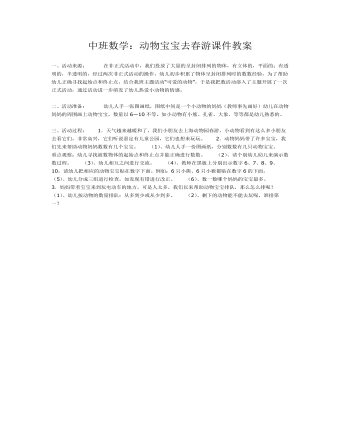
中班数学:动物宝宝去春游课件教案
二、活动准备: 幼儿人手一张图画纸,图纸中间是一个小动物的妈妈(教师事先画好)幼儿在动物妈妈的周围画上动物宝宝,数量以6—10不等。如小动物有小熊、孔雀、大象、等等都是幼儿熟悉的。三、活动过程: 1.天气越来越暖和了,我们小朋友去上海动物园春游,小动物看到有这么多小朋友去看它们,非常高兴,它们听说嘉定有儿童公园,它们也想来玩玩。 2.动物妈妈带了许多宝宝,我们先来帮助动物妈妈数数有几个宝宝。 (1)、幼儿人手一份图画纸,分别数数有几只动物宝宝。 重点观察:幼儿寻找被数物体的起始点和终止点并能正确进行数数。
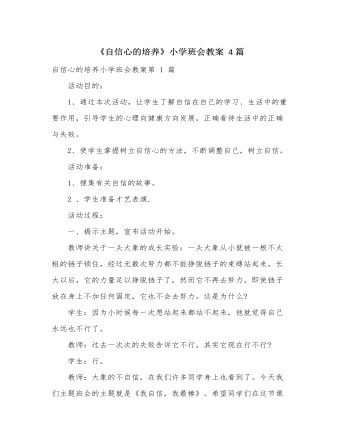
《自信心的培养》小学班会教案 4篇
一、活动目标自信是成功的必要条件,是成功的源泉。相信自己行,是一种信念。自信是人对自身力量的一种确信,深信自己一定能做成某件事,实现所追求的目标。本次班会以自信为主题,提升同学们在日常生活和学习中的自信心。二、活动准备全班同学预先学会唱《明天会更好》这首歌两位同学准备好小品,电脑,vcd,活动道具等三、活动过程:1.班主任致辞:我们班是一个团结友爱,上进的班级,同学之间的感情深厚。为了我们在以后的日子里更好的学习,深刻了解自信重要性,我们班特地搞了这次的主题班会。下面宣布主题班会开始。2.男女主持人发言,宣布主题班会开始。3.全班合唱明天会更好。(充分利用电脑,vcd带唱)4.通过演小品。分清自信,自卑,自大,充分说明自信的重要。5、举例说明怎样建立和加强自己的自信心。
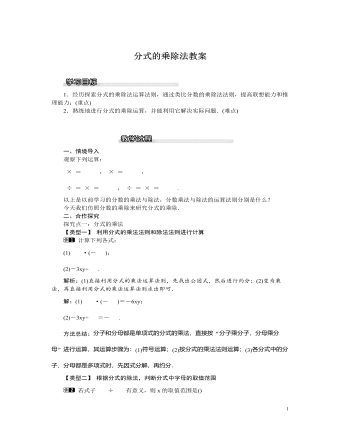
北师大初中八年级数学下册分式的乘除法教案
通常购买同一品种的西瓜时,西瓜的质量越大,花费的钱越多,因此人们希望西瓜瓤占整个西瓜的比例越大越好.假如我们把西瓜都看成球形,并把西瓜瓤的密度看成是均匀的,西瓜的皮厚都是d,已知球的体积公式为V=43πR3(其中R为球的半径),求:(1)西瓜瓤与整个西瓜的体积各是多少?(2)西瓜瓤与整个西瓜的体积比是多少?(3)买大西瓜合算还是买小西瓜合算?解析:(1)根据体积公式求出即可;(2)根据(1)中的结果得出即可;(3)求出两体积的比即可.解:(1)西瓜瓤的体积是43π(R-d)3,整个西瓜的体积是43πR3;(2)西瓜瓤与整个西瓜的体积比是43π(R-d)343πR3=(R-d)3R3;(3)由(2)知,西瓜瓤与整个西瓜的体积比是(R-d)3R3<1,故买大西瓜比买小西瓜合算.方法总结:本题能够根据球的体积,得到两个物体的体积比即为它们的半径的立方比是解此题的关键.

